Think you have scales on plants? Learn how to identify and get rid of scale bugs. Scale are sucking pests like mealy bugs, thrips, aphids and whitefly.
In fact, white scale pests can look much like mealy bugs (a relative).
Scale, like other sucking insects, secretes a sticky honey dew onto your plants. Grey sooty mold is often seen with infestations.
Herder ants Love honey dew. If you see ants on your plant look for scale and other sucking insects.
What is Scale On Plants?
Scale bugs are plant pests that attach themselves onto your plant leaves and stems in colonies.
They are most often soft bodied on houseplants. You will see scale armored with a hard shell on garden plants and trees.
They create visible mounds on leaves and stems.
Under that mound is a piercing mouth piece that sucks the juice out of plant cells.
Life cycle:
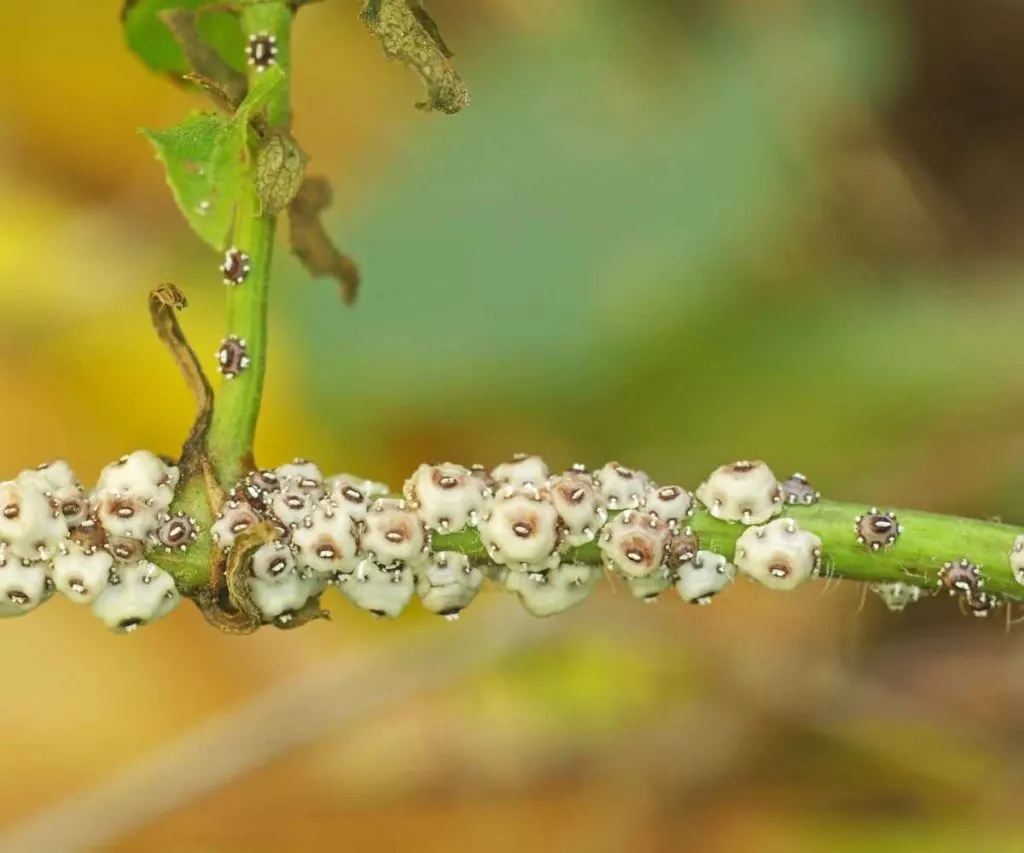
Scale life cycle is pretty simple. There are three stages of scale. Adult, egg and immature scale.
An adult Female scale produces eggs and incubates them under the mound (or in cottony material like mealy bugs). Outdoors, the scale will often winter over in this stage.
In spring, Tiny six legged crawlers emerge from under the mounds. They find a new fresh juicy piece of the plant or tree.
They pierce the plant veins to feed, and stay there. The body transforms and hardens into the adult form. They no longer move.
Life cycle is repeated. Scale make several generations a year.
What does Scale Look Like on Plants?
There are many varieties of scale. Scale bugs on plants may be red, white or brown lumps on your plant stems and leaves.
Soft bodied brown scale are the most common on indoor plants.
a Colony of white Scale can look like mealy bugs at a glance. Mealy bugs however, are mobile and can be treated like aphids.
If you see firm stuck lumps on the leaves or stem, suspect scale. An adult scale will not move. Immature scale only move to find a new home. Then they attach.
Scale are found in groups usually. They tend to populate as seen below along the vines of the plant or plant ribs. That is where they like to feed.
You will also see them grouped along a stem in colonies.
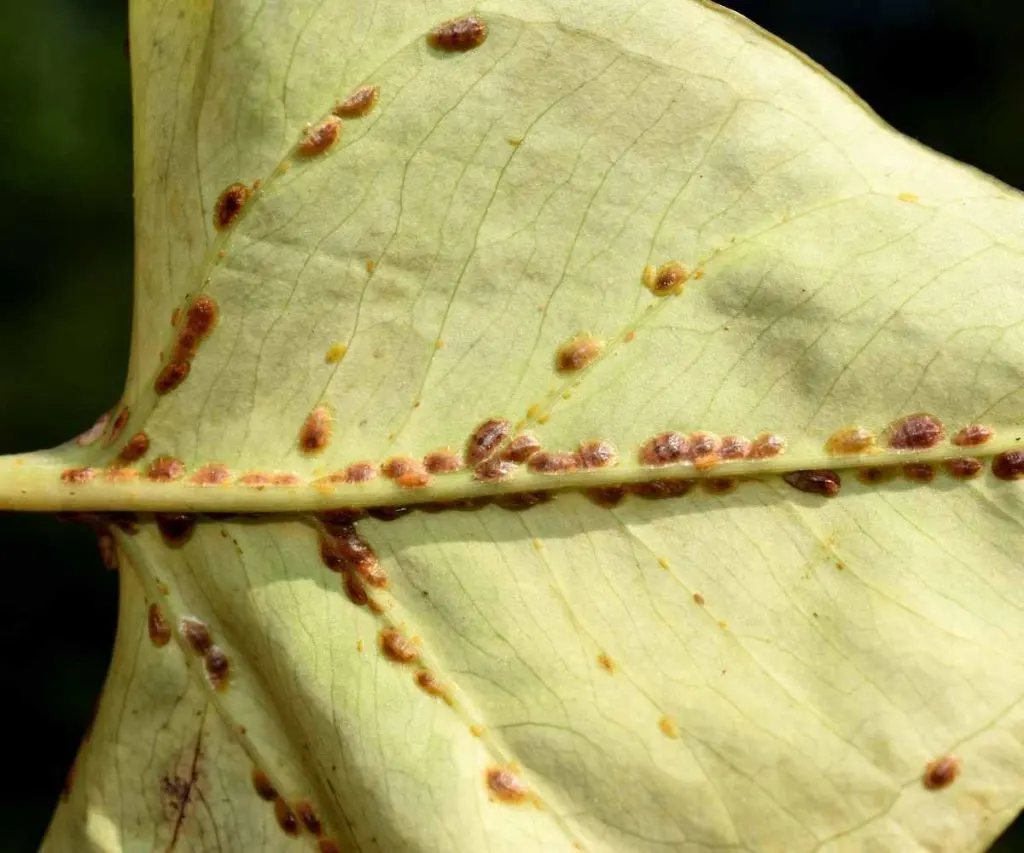
How to Get Rid Of Scale On Plants:
The best eradication method is prevention. When you purchase plants look for pests. Quarantine all new plants for several weeks to a month. This ensures the life cycle of pests completes.
Treat any new suspicious plants with neem oil soap to prevent a new pest population from forming in your home.
When bringing in plants from outside for winter treat the plant to quarantine, pest inspection and spray it with neem oil soap.
How to get rid of scale on plants indoors:
- Quarantine ALL infested plants. Inspect and Treat any plants close to where the infection occurred.
- Hard spray of water will dislodge soft bodied scale to some degree.
- Soft bodied scale and immature forms can be killed with an insecticidal soap spray regime. We have a recipe posted below for our homemade insecticidal Neem Oil soap. It will work great if the scale body is soft or immature.
- For best results combine the initial hard water spray with hand removal of scale from leaves and stem. Then follow up with the insecticidal spray. This needs to be repeated at least weekly to eradicate all the life stages of scale.
How to get rid of scale on plants outdoors.
- Heavily infested plants should be removed. Treat surrounding plants as needed.
- Scrape them off the plant Or crush them. Insecticidal soaps cannot penetrate hard scale armor. However, it is effective on juvenile scale. Repeat spray often.
- Dormant oil sprays are effective for use in the dormant season for orchard trees.
- Beneficial Insects can also control scale outdoors.
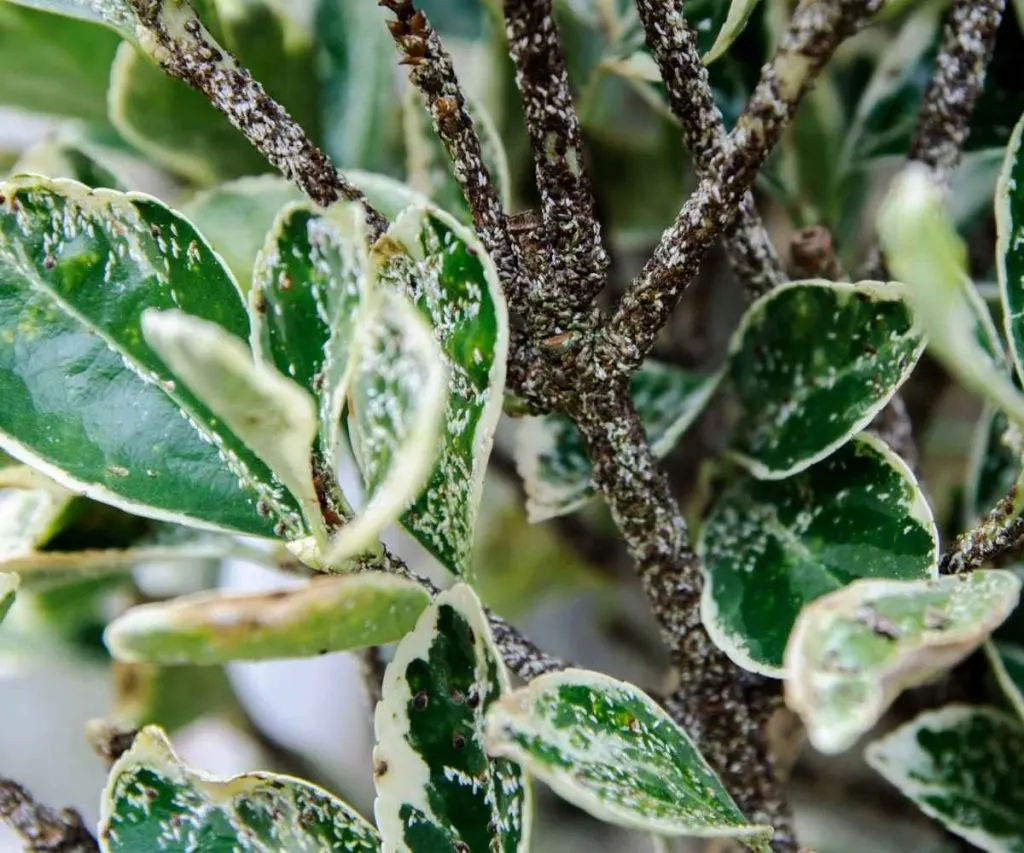
Heavy infestations of Scale bugs on plants are not usually worth the battle. Best to dispose of the plant.
How To Safely Dispose Of Infested HousePlants:
If you see a LOT of pest damage and want to get rid of the plant rather than treat it, here’s the proper way to do it.
- Take the whole plant and set it in an airtight garbage bag.
- Seal the bag.
- Throw it into the garbage OUTSIDE.
- Do NOT throw a plant live with pests into your compost pile or anywhere they can continue their life cycle.
- Be sure to sterilize the home surfaces you and the plant came in contact with.
- Any other houseplants grouped together with the affected one should also be checked for pests and sprayed with a neem oil insecticidal spray.
NEVER compost plants with pests, molds and fungal infections. You will just spread these problems into your compost.
The Contented Plant
Homemade Insecticidal Soap Recipe
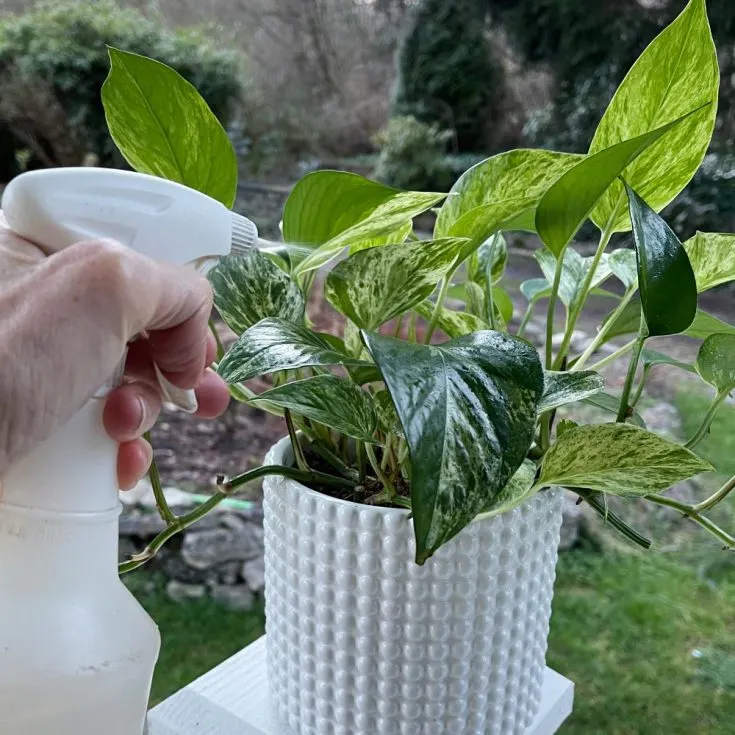
This Insecticidal soap Spray Recipe with Neem oil is effective for spider mites, thrips, and soft-bodied insects on plants, such as aphids, young scales, whiteflies and mealybugs. Only a deterrent to caterpillars and beetle larvae but this recipe will control boxelder bugs when they are still in the small nymph stages.
Materials
- 1/2 Teaspoon pure Castile liquid dish soap (or other organic liquid soap)
- 1 Tsp. Neem Oil
- 1 quart water-soft or average hard water for best results.
- OPTIONAL:
- A few added drops of lavender, peppermint, or orange oil
Instructions
- mix the water and soap into a solution. Do NOT shake as it will cause lots of bubbles.
- Pour solution into the spray bottle.
- spray on the affected plant leaves on the top and bottom.
- Also spray stems, intersections and buds of flowers.
- Leave the solution on the plants overnight.
- Spray the plants with water after 12 hours of so to rinse the leaves and remove dead aphids.
- Reapply as needed. To interrupt the aphid life cycle spray every three days for two weeks.
Although the basic recipe will work as described you may wish to enhance your formula by adding
A few added drops of lavender, peppermint, or orange oil in this recipe will help repel pests and smells great!
Notes
Sensitivity of Plants:
If you find this recipe is too harsh and burns your plants. Cut the soap amount in half or follow this spray with an immediate spray of plain water to protect your plant leaves. Also sensitive plants like ferns, succulents, azaleas and waxy leaved plants may be harmed by this spray.
Water Hardness matters:
This recipe is most effective with average to soft water. A hard water will yield a less effective insecticidal spray recipe and can leave soap scum on your plant leaves.
How to use this Spray:
- DIY Organic Insecticidal Soap Recipe works on contact which means it must coat the insect to kill it.
- This spray has No residual effect and must be applied several times at weekly intervals for best control. Although neem oil has some lasting impact on insects most of the effectiveness of this spray is by direct contact.
- Spray the entire plant with special focus on those areas of your plant where you can find the bugs.
- Spray in the morning or evening in cooler temperatures and when plants are shaded. You want the spray to last. Once it dries the spray is ineffective.
Go to our Homemade Food Junkie article For more on this recipe
The cost of this recipe is determined by which soap you use and if you have to purchase a spray bottle.
This insecticidal soap is not effective on fungus gnats. Read this article on how to kill and manage Fungus Gnats
Follow Us:
Find us on YouTube, Instagram , Pinterest and TikTok! We love to Plant chat. We also comment, like and occasionally share your content to our daily stories. We’d love to see your plants. Share your joy in your houseplants. Happy Planting!
Recent Posts:
Further Reading:
- General information in scale by Greenery unlimited article.
- Scale insect on indoor plants by University of Maryland
- Information on scale control on outdoor trees and plants by Washington State University
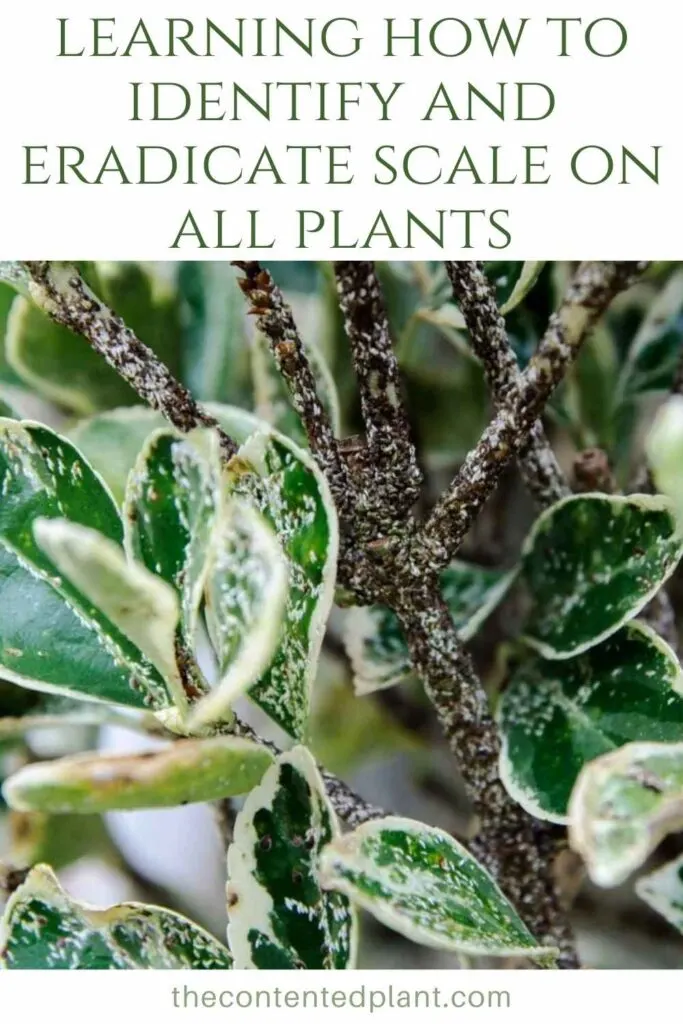

Cat Palm - The Contented Plant
Tuesday 20th of December 2022
[…] Scale insects: These are small, hard-bodied insects that attach themselves to the stems and leaves of cat palms. They feed on plant juices and can cause yellowing and wilting of the leaves if left uncontrolled. Scale insects can be identified by the small, circular or oval-shaped bumps on the plant’s stems and leaves. […]